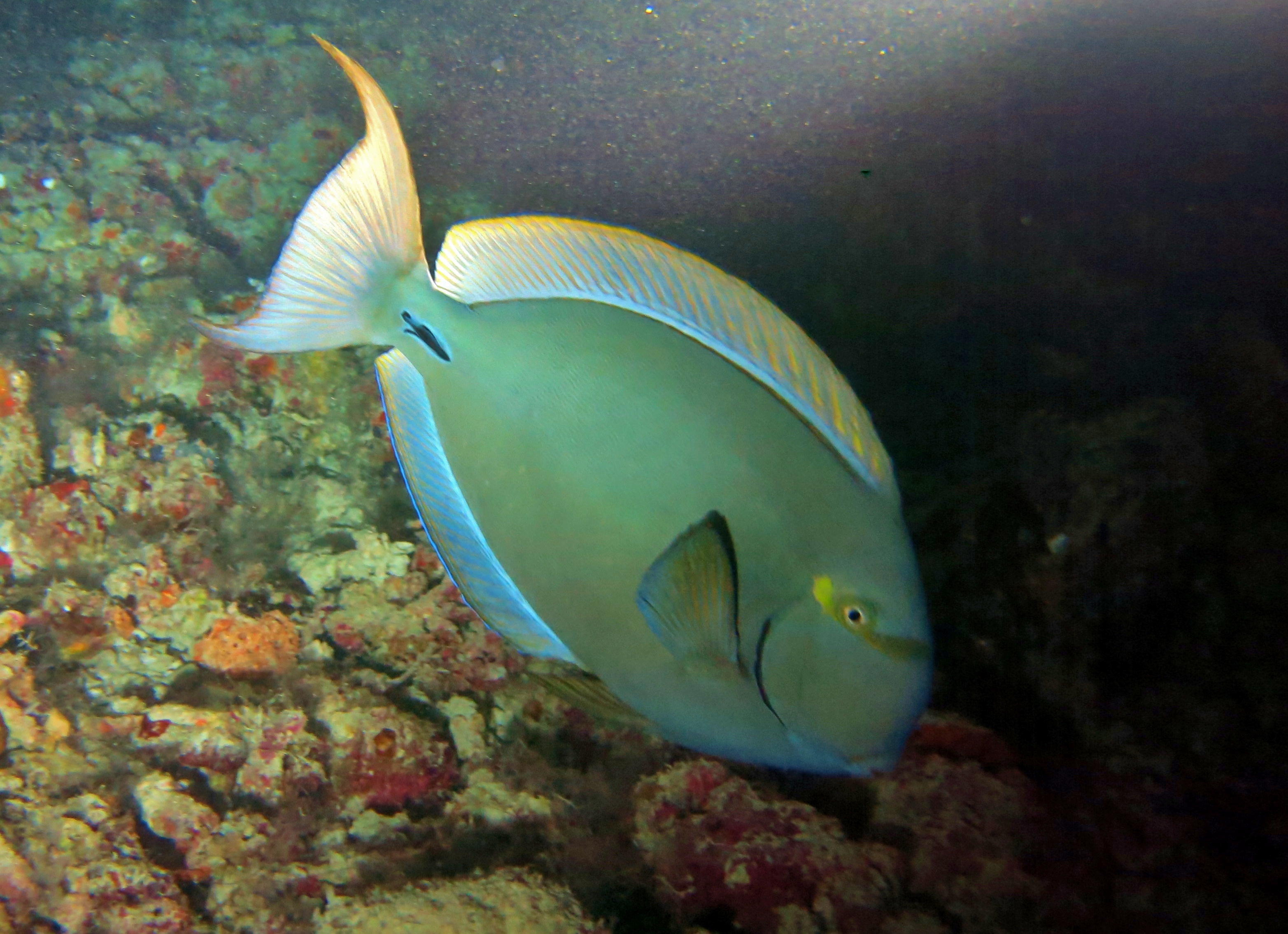Yellowfin Surgeon on:
[Wikipedia]
[Google]
[Amazon]
The yellowfin surgeonfish or Cuvier's surgeonfish (''Acanthurus xanthopterus'') is one of several marine
 It lives near
It lives near
fish
Fish are aquatic, craniate, gill-bearing animals that lack limbs with digits. Included in this definition are the living hagfish, lampreys, and cartilaginous and bony fish as well as various extinct related groups. Approximately 95% of ...
that change color as they get older. This characteristic confused fish identification, and originally put the young and adults in different species
In biology, a species is the basic unit of classification and a taxonomic rank of an organism, as well as a unit of biodiversity. A species is often defined as the largest group of organisms in which any two individuals of the appropriate s ...
. With the arrival of aquaria and later, coral reef
A coral reef is an underwater ecosystem characterized by reef-building corals. Reefs are formed of colonies of coral polyps held together by calcium carbonate. Most coral reefs are built from stony corals, whose polyps cluster in groups.
C ...
aquaculture, specialists noticed the color transformation. Only recently have zoologists
This is a list of notable zoologists who have published names of new taxa under the International Code of Zoological Nomenclature.
A
* Abe – Tokiharu Abe (1911–1996)
* Abeille de Perrin, Ab. – Elzéar Abeille de Perrin (1843–1910)
* ...
begun to understand their metamorphosis.
Description
The yellowfin surgeonfish ranges in length to . It has eight or 9 dorsal spines, 25-27 dorsal soft rays, three anal spines, 23-25 anal soft rays, and 16-24 anterior and 17-22 posteriorgill raker
Gill rakers in fish are bony or cartilaginous processes that project from the branchial arch (gill arch) and are involved with suspension feeding tiny prey. They are not to be confused with the gill filaments that compose the fleshy part of the ...
s.
Its body is purplish gray. It has a region of dull yellow in front of its eye. The outer third of its pectoral fin
Fins are distinctive anatomical features composed of bony spines or rays protruding from the body of a fish. They are covered with skin and joined together either in a webbed fashion, as seen in most bony fish, or similar to a flipper, as ...
is yellow, the extreme distal part is hyaline. Its dorsal and anal fins are yellowish grey basally and dull yellow distally. Its caudal fin
Fins are distinctive anatomical features composed of bony spines or rays protruding from the body of a fish. They are covered with skin and joined together either in a webbed fashion, as seen in most bony fish, or similar to a flipper, as ...
is purplish and the caudal spine is small.
Range and habitat
coral reef
A coral reef is an underwater ecosystem characterized by reef-building corals. Reefs are formed of colonies of coral polyps held together by calcium carbonate. Most coral reefs are built from stony corals, whose polyps cluster in groups.
C ...
s at depths ranging from . Its preferred temperatures are 24–28 °C (75–82 °F) at latitudes of 30°N to 30°S. It ranges from East Africa to the Hawaiian Islands and French Polynesia, north to southern Japan, south to the Great Barrier Reef
The Great Barrier Reef is the world's largest coral reef system composed of over 2,900 individual reefs and 900 islands stretching for over over an area of approximately . The reef is located in the Coral Sea, off the coast of Queensland, ...
, and New Caledonia, and in the Eastern Pacific, from the lower Gulf of California
The Gulf of California ( es, Golfo de California), also known as the Sea of Cortés (''Mar de Cortés'') or Sea of Cortez, or less commonly as the Vermilion Sea (''Mar Bermejo''), is a marginal sea of the Pacific Ocean that separates the Baja C ...
and Clipperton Island
Clipperton Island ( or ; ) is an uninhabited, coral atoll in the eastern Pacific Ocean. It is from Paris, France, from Papeete, Tahiti, and from Mexico. It is an overseas state private property of France under direct authority of the Minis ...
to Panama
Panama ( , ; es, link=no, Panamá ), officially the Republic of Panama ( es, República de Panamá), is a transcontinental country spanning the southern part of North America and the northern part of South America. It is bordered by Co ...
and the Galapagos Islands.
Juveniles inhabit shallow, protected, turbid inshore waters, while adults prefer deeper areas of protected bays and lagoons.
Feeding
It feeds on diatoms, detritus film ofsand
Sand is a granular material composed of finely divided mineral particles. Sand has various compositions but is defined by its grain size. Sand grains are smaller than gravel and coarser than silt. Sand can also refer to a textural class o ...
, filamentous algae
Algae (; singular alga ) is an informal term for a large and diverse group of photosynthetic eukaryotic organisms. It is a polyphyletic grouping that includes species from multiple distinct clades. Included organisms range from unicellular micr ...
, hydroids
Hydroids are a life stage for most animals of the class Hydrozoa, small predators related to jellyfish.
Some hydroids such as the freshwater '' Hydra'' are solitary, with the polyp attached directly to the substrate. When these produce buds ...
, and pieces of fish. It is probably the only surgeonfish that readily takes bait.
References
External links
*http://filaman.ifm-geomar.de/summary/SpeciesSummary.php?id=1261 *http://www.zanclus.it/mysql/immagini/acanthuridae.php * {{Taxonbar, from=Q2182371 Acanthurus Fish of Hawaii Taxa named by Achille Valenciennes Fish described in 1835